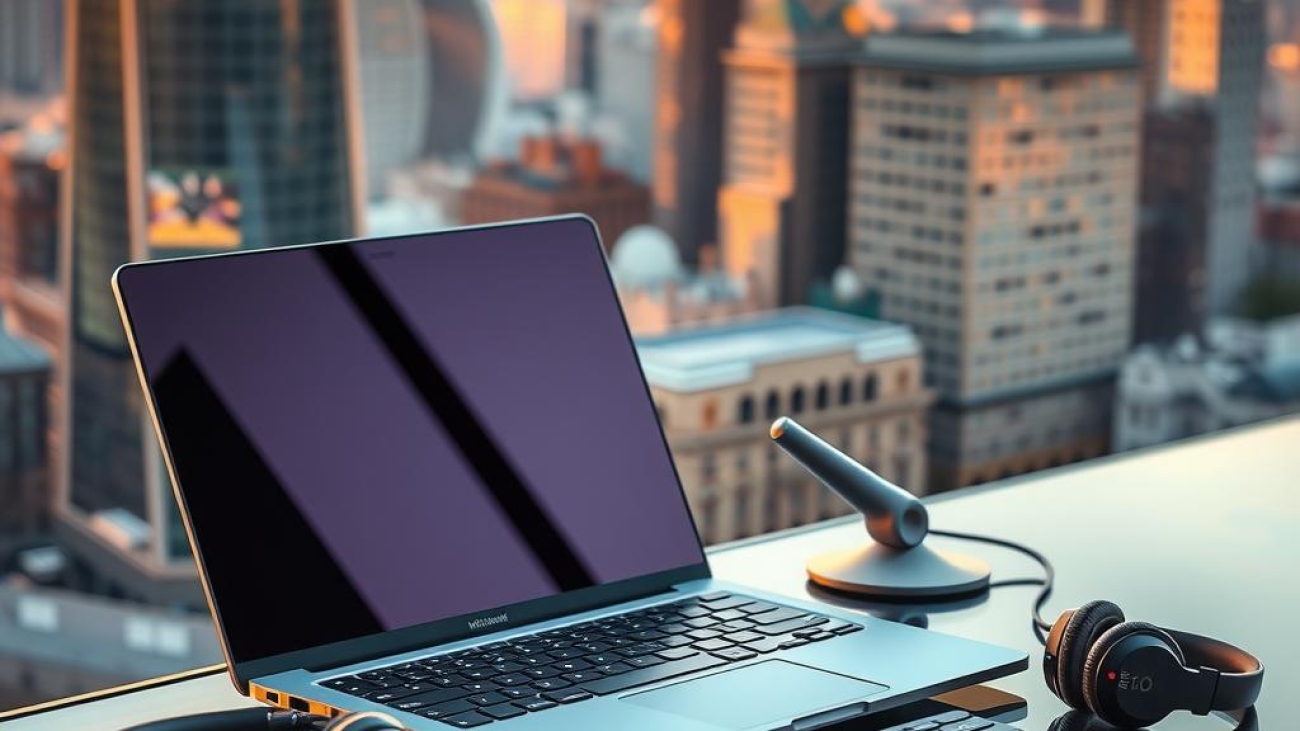In a world where remote work has become the norm, how can traveling professionals maintain productivity without sacrificing convenience? The answer lies in adopting innovative workspace solutions that allow for seamless multitasking on the go. A portable second monitor is an essential tool in this scenario, transforming any travel setup into a mobile workstation that rivals traditional office environments. By integrating a second monitor, professionals can enhance their workflow and manage multiple tasks simultaneously, significantly boosting efficiency during business trips or while working from coffee shops.
This article delves into the core value of utilizing a portable monitor as part of an effective professional setup. It explores various options available to those who seek to elevate their remote work experience with dual display capabilities. Whether it’s for presentations, data analysis, or simply managing emails alongside video calls, having a portable second monitor opens up new avenues for productivity and organization. Join us as we uncover practical tips and top product recommendations to create an optimal travel-ready workspace that meets the demands of modern professionals everywhere.

Key Points:
-
Enhanced Productivity on the Go: A portable second monitor significantly boosts productivity for traveling professionals. With the ability to set up a dual display, users can easily manage multiple tasks simultaneously, whether they are working from a hotel room or a bustling café. This flexibility allows for improved workflow and efficient task management while on the move.
-
Seamless Integration into Mobile Workstations: The design of a portable monitor facilitates its incorporation into any mobile workstation. Professionals can quickly connect their devices without cumbersome setups, ensuring that they maintain an organized and effective professional setup. This adaptability enhances user experience by providing additional screen real estate wherever needed.
-
Collaboration Made Easy: In today’s remote work environment, effective collaboration is crucial. A second monitor enables traveling professionals to share presentations or documents with colleagues effortlessly during virtual meetings. By expanding their workspace with this innovative tool, users foster better communication and teamwork regardless of geographical limitations, making it an essential component of modern workspace solutions.

The Evolution of Remote Work
Adapting to a New Normal in Professional Environments
The landscape of work has undergone a profound transformation over the past few years, with remote work becoming a standard practice rather than an exception. This shift has allowed employees to enjoy increased flexibility and improved work-life balance but has also introduced unique challenges. One significant hurdle is the limitation of screen space, particularly for those who are used to working on multiple displays in traditional office settings. In this context, a portable second monitor emerges as an essential productivity tool that can seamlessly integrate into any mobile workstation setup. By expanding digital real estate, professionals can enhance their workflow efficiency while maintaining the benefits of remote work environments. Imagine juggling spreadsheets, video calls, and presentations all at once; having that extra screen becomes not just beneficial but indispensable.
Balancing Portability with Functionality
Addressing Space Constraints While Traveling
As individuals increasingly take their professional lives on the road—whether commuting from home or traveling for business—the demand for workspace solutions that prioritize portability without compromising functionality is surging. Many workers find themselves confined to small desks or coffee shop tables where limited screen space can stifle productivity and creativity. Herein lies the advantage of incorporating a portable second monitor into one’s travel setup: it transforms any cramped environment into an efficient dual display system that mimics traditional office setups. This transition allows users to easily manage multiple applications side by side without straining their eyes or toggling between tabs incessantly. Moreover, advancements in technology have led to lightweight models designed specifically for nomadic professionals seeking versatility alongside performance.
Enhancing Productivity Through Dual Display Systems
The Power of Extended Screen Real Estate
Utilizing two screens instead of one is not merely about aesthetics; it fundamentally enhances productivity levels across various tasks—from coding and graphic design to data analysis and project management. Studies have shown that dual-display systems significantly reduce time spent switching between applications while increasing focus on assigned tasks due to minimized distractions caused by cluttered windows on smaller screens. For remote workers seeking ways to optimize their output from home offices or co-working spaces alike, integrating a portable second monitor serves as both an innovative solution and smart investment in future endeavors—a game-changer for anyone serious about elevating their professional capabilities within these evolving workspace dynamics.
Redefining Workspace Solutions
Embracing Flexibility Without Sacrificing Efficiency
The modern workforce demands adaptable solutions tailored around individual needs while promoting collaboration among teams regardless of geographical boundaries—a challenge met effectively through portable technologies like portable second monitors. These devices reflect how companies are rethinking traditional approaches towards employee engagement by providing tools conducive not only for enhanced personal workflows but also facilitating shared experiences during virtual meetings or brainstorming sessions amongst colleagues scattered across diverse locations worldwide. As organizations continue embracing hybrid models combining remote efforts with occasional in-person interactions facilitated through superior tech innovations such as dual displays paired within compact frameworks—flexibility remains paramount without sacrificing operational efficiency essential amidst these changing times!
Choosing the Right Size for Your Portable Monitor
Understanding Size Variability in Portable Monitors
When selecting a portable second monitor, one of the most critical factors to consider is size. The dimensions of a monitor can greatly influence your travel setup and overall user experience. Generally, portable monitors range from 13 inches to 17 inches diagonally, but it’s crucial to determine what best suits your workspace solutions and lifestyle needs. For instance, a larger screen might enhance productivity during remote work by providing ample space for multiple windows when using dual display setups. However, portability should also be considered; a smaller form factor may be advantageous for those constantly on the move or confined to limited desk space. Users must balance their desire for screen real estate with practicality – ensuring that any chosen model fits comfortably within their mobile workstation without compromising ease of transport.
Resolution Matters: Clarity and Detail
Importance of Display Quality in Productivity Tools
Resolution plays an integral role in the efficacy of a portable second monitor. Higher resolutions such as Full HD (1920×1080) or even 4K (3840×2160) provide sharper images and allow users to view intricate details clearly—essential features especially beneficial for professionals engaged in graphic design or video editing tasks. A high-resolution portable monitor not only enhances visual clarity but also improves overall productivity by reducing eye strain over long working hours. When selecting between options, users should evaluate how often they will utilize high-definition content versus standard applications since this could impact decision-making regarding budget allocation towards more premium models versus standard offerings.
Connectivity Options: Versatility is Key
Ensuring Seamless Integration with Devices
Another essential feature influencing the choice of a portable second monitor is connectivity options available on various models—this determines compatibility with laptops and other devices frequently used within professional setups. USB-C has emerged as an industry-standard due to its ability to deliver both power and data through one cable; however, HDMI ports remain prevalent as well among traditional setups. Consideration must also extend toward additional features like built-in speakers or integrated stands which can further enhance usability while creating effective workspace solutions without needing extra peripherals cluttering your environment.
Portability Features: Designed for Travel
Assessing Weight and Durability
For individuals who prioritize mobility alongside functionality, assessing weight and durability becomes paramount when choosing their portable second monitor option. Generally speaking, lighter models facilitate easy transport while traveling; ideally weighing under five pounds ensures hassle-free movement whether commuting daily or embarking on longer journeys related to remote work projects across different locations worldwide where setting up efficient dual displays might otherwise pose challenges due limitations imposed by conventional hardware specifications found at temporary workstations away from home base environments.
Enhancing User Experience Through Additional Features
Exploring Extra Functionalities
Finally, beyond basic specifications lie several additional functionalities worth exploring that could significantly improve user experience with any selected portable second monitor unit being considered today—these include adjustable brightness settings catering specifically towards varied lighting conditions encountered throughout day-to-day use scenarios along various environments encountered while utilizing these innovative productivity tools across diverse applications requiring adaptability based upon situational demands faced routinely during operations performed either inside office spaces designed specifically around conducive workflows aimed solely at accomplishing productive outcomes expected consistently each time!
Enhancing Your Mobile Workstation
Integrating a Portable Monitor for Maximum Efficiency
In today’s fast-paced world, the ability to work remotely and maintain productivity is essential. One effective way to boost output while on the go is by incorporating a portable second monitor into your travel setup. This addition transforms any environment into an efficient mobile workstation, significantly enhancing multitasking capabilities. For professionals accustomed to dual displays in traditional office settings, having a second monitor can replicate that experience anywhere—be it in a coffee shop or at an airport lounge. The compact design of modern portable monitors allows for easy transport alongside laptops and other essentials without compromising space or weight limits typical of carry-on luggage. When selecting a portable monitor, consider factors such as screen size, resolution, and connectivity options; many models feature USB-C connections that streamline setup with minimal cables.
Optimizing Your Workspace Solutions
Achieving Seamless Connectivity and Functionality
To maximize productivity when using a portable second monitor, it’s crucial to ensure seamless integration within your existing tech ecosystem. Most current laptops support multiple display outputs; hence adjusting settings can allow users to extend their desktop rather than mirroring screens—a critical step for those who rely on expansive workspaces while traveling. By leveraging applications designed for dual displays, individuals can organize their digital workspace more effectively: keep communication tools like Slack open on one screen while working on documents or spreadsheets on the other. Furthermore, employing ergonomic accessories such as laptop stands can elevate your primary device closer to eye level while positioning the second monitor comfortably beside it helps reduce strain during lengthy sessions of remote work.
Practical Tips for Effective Use
Making the Most Out of Dual Display Setups
When setting up this professional arrangement in various environments, it’s advisable to experiment with different layouts until finding what feels most natural and productive. Utilizing features such as portrait mode on your portable second monitor allows reading lengthy documents without extensive scrolling—an invaluable time-saver for professionals reviewing reports or drafting proposals during travel hours. Additionally, maintaining organized desktops across both screens enhances focus by minimizing distractions from unnecessary tabs or windows cluttering up valuable real estate on either display. Regularly decluttering digital files ensures swift access when needed; thus supporting overall workflow efficiency becomes achievable through consistent habits combined with smart technology choices like investing in high-quality portable monitors tailored towards enhancing mobile setups specifically designed for productivity-driven individuals seeking versatile workspace solutions.
Frequently Asked Questions:
Q: What is a portable second monitor, and how can it benefit traveling professionals?
A: A portable second monitor is a lightweight display that can easily connect to laptops or tablets, providing an additional screen for enhanced productivity. For traveling professionals, this device allows for a more efficient mobile workstation, enabling multitasking and improved organization while on the go.
Q: How do I set up my portable monitor with my laptop?
A: Setting up a portable monitor typically involves connecting it via USB-C or HDMI cables. Most modern devices are plug-and-play compatible, meaning they automatically detect the external display. Once connected, users can extend their desktop to create a dual display setup that enhances workflow during remote work sessions.
Q: Are there specific features to look for in a portable second monitor?
A: When selecting a portable second monitor, travelers should consider factors such as size and weight for easy transport, resolution for clear visuals, and connectivity options like USB-C or HDMI ports. Additionally, some monitors come with built-in batteries which add convenience when setting up your professional setup without requiring an external power source.
